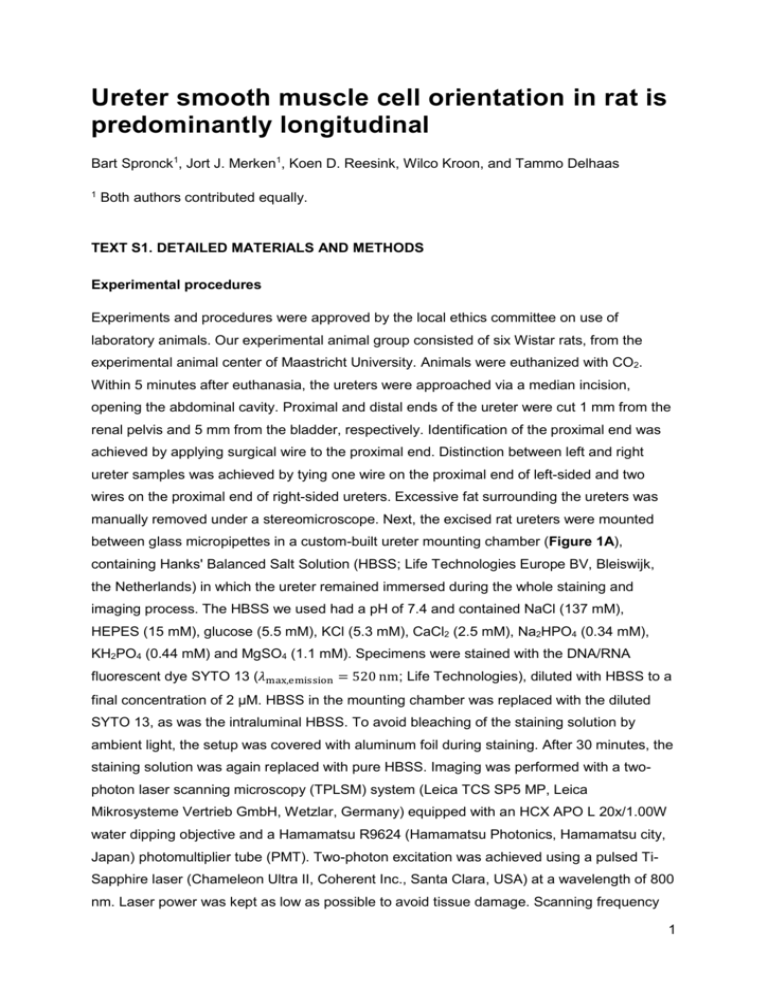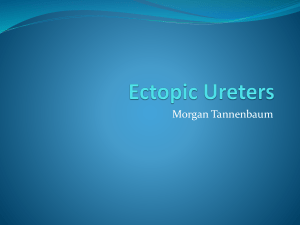Text S1 - Figshare
advertisement

Ureter smooth muscle cell orientation in rat is
predominantly longitudinal
Bart Spronck1, Jort J. Merken1, Koen D. Reesink, Wilco Kroon, and Tammo Delhaas
1
Both authors contributed equally.
TEXT S1. DETAILED MATERIALS AND METHODS
Experimental procedures
Experiments and procedures were approved by the local ethics committee on use of
laboratory animals. Our experimental animal group consisted of six Wistar rats, from the
experimental animal center of Maastricht University. Animals were euthanized with CO2.
Within 5 minutes after euthanasia, the ureters were approached via a median incision,
opening the abdominal cavity. Proximal and distal ends of the ureter were cut 1 mm from the
renal pelvis and 5 mm from the bladder, respectively. Identification of the proximal end was
achieved by applying surgical wire to the proximal end. Distinction between left and right
ureter samples was achieved by tying one wire on the proximal end of left-sided and two
wires on the proximal end of right-sided ureters. Excessive fat surrounding the ureters was
manually removed under a stereomicroscope. Next, the excised rat ureters were mounted
between glass micropipettes in a custom-built ureter mounting chamber (Figure 1A),
containing Hanks' Balanced Salt Solution (HBSS; Life Technologies Europe BV, Bleiswijk,
the Netherlands) in which the ureter remained immersed during the whole staining and
imaging process. The HBSS we used had a pH of 7.4 and contained NaCl (137 mM),
HEPES (15 mM), glucose (5.5 mM), KCl (5.3 mM), CaCl2 (2.5 mM), Na2HPO4 (0.34 mM),
KH2PO4 (0.44 mM) and MgSO4 (1.1 mM). Specimens were stained with the DNA/RNA
fluorescent dye SYTO 13 (𝜆max,emission = 520 nm; Life Technologies), diluted with HBSS to a
final concentration of 2 µM. HBSS in the mounting chamber was replaced with the diluted
SYTO 13, as was the intraluminal HBSS. To avoid bleaching of the staining solution by
ambient light, the setup was covered with aluminum foil during staining. After 30 minutes, the
staining solution was again replaced with pure HBSS. Imaging was performed with a twophoton laser scanning microscopy (TPLSM) system (Leica TCS SP5 MP, Leica
Mikrosysteme Vertrieb GmbH, Wetzlar, Germany) equipped with an HCX APO L 20x/1.00W
water dipping objective and a Hamamatsu R9624 (Hamamatsu Photonics, Hamamatsu city,
Japan) photomultiplier tube (PMT). Two-photon excitation was achieved using a pulsed TiSapphire laser (Chameleon Ultra II, Coherent Inc., Santa Clara, USA) at a wavelength of 800
nm. Laser power was kept as low as possible to avoid tissue damage. Scanning frequency
1
was set to 600 lines per second. Resolution (1480x1480 pixels) and field of view size
(738x738 µm2) were kept constant throughout the imaging process, resulting in a pixel size of
0.5x0.5 µm2.
Image stacks were acquired at 12 bits and with an inter-slice distance of 0.5 µm, traversing
the ureter wall from out- to inside. Three image stacks were acquired along the length of the
ureter at proximal, middle and distal positions. After acquisition, lateral field of view was
reduced by cropping the images to a resolution of 512x512 pixels to ease further processing
and limit computation time.
Processing and analysis
Cropping and diameter assessment
In each acquired stack, ureter diameter was assessed by showing a transversal section
through the stack and drawing a circle on screen using ImageJ 1.47v (National Institutes of
Health, Bethesda, Maryland, USA). After diameter assessment, the lateral field of view was
reduced by cropping the images to a resolution of 512x512 pixels to ease further processing
and limit computation time. All further processing was performed using MATLAB R2013b
(The MathWorks Inc, Natick, Massachusetts, USA).
Cellness filtering
Stack images were filtered using cellness filtering, in analogy to vesselness filtering [1]. This
filtering is a technique originally developed to enhance blood vessels in 2D or 3D image
stacks [1]. Cellness filtering enhances elongated structures (in this case, SMC nuclei) in an
image and suppresses background noise, thereby resulting in a high-contrast image with
clearly delineated cell nuclei.
First, for each pixel, a Hessian matrix ℍ is computed:
∂2 𝐼
|
∂𝑥 2 𝑥,𝑦
∂2 𝐼
|
∂𝑥 ∂𝑦 𝑥,𝑦
∂2 𝐼
|
∂𝑥 ∂𝑦 𝑥,𝑦
∂2 𝐼
|
∂𝑦 2 𝑥,𝑦
ℍ(𝑥, 𝑦) = [
],
with 𝐼(𝑥, 𝑦) being the image intensity at a given point. Hessian terms are calculated by
convolution of the image with the respective second-order derivatives of a 2D Gaussian
kernel 𝐺:
𝐺(𝑥, 𝑦) =
2 2
2
𝑒 −(𝑥 +𝑦 )⁄2σ
2πσ2
,
2
in which σ is the kernel standard deviation (Table S1). Second, for each pixel, the
eigenvalues (|λℍ,1 | ≤ |λℍ,2 |) of ℍ are computed, which are subsequently used to calculate
blobness (0 ≤ 𝑅B ≤ 1) and structureness (𝑆 ≥ 0):
λ
𝑅B = |λℍ,1 | , and
ℍ,2
𝑆 = √λ2ℍ,1 + λ2ℍ,2 .
For pixels in an isotropic structure, in which the eigenvalues are approximately equal, 𝑅B = 1;
whereas for pixels in an anisotropic structure, 𝑅B → 0. Cell pixels can be distinguished from
background pixels by 𝑆, because the magnitude of the derivatives (and thus of the
eigenvalues) in background pixels is small [1]. 𝑅B and 𝑆 are combined into cellness (0 ≤ 𝐶 ≤
1) using
0
if λℍ,2 > 0
𝐶 = { −𝑅B2⁄2β2
,
−𝑆 2 ⁄2γ2
(𝑒
) ∙ (1 − e
)
with β and γ being parameters weighing blobness and structureness, respectively (Table
S1).
Smooth muscle cell identification
Cellness-filtered images were thresholded at ϑC (Table S1), yielding binary images. In these
images, pixels of value 1 were clustered based on their 8-adjacency [2], each cluster
signifying an SMC. Clusters were subsequently filtered based on the their surface area using
lower and upper thresholds of ϑA,↓ and ϑA,↑, respectively (Table S1).
Region of interest application
As flat image slices were acquired of a curved object, structures (clusters) at various depths
of the wall could end up in one image slice. This crosstalk among slices can be reduced by
narrowing the ROI used for quantification of SMC orientation (Figure 1B). With increasing
imaging depth (𝑧), and thus with a decreasing radius of curvature of the ureter wall, the ROI
should narrow. For a certain effective slice thickness (Δ𝑟max = 𝑟2 − 𝑟1 = 6 μm, Figure 1B and
Table S1), it can be shown that for the crosstalk-limiting ROI (𝑅I,cl (𝑧)), it holds that:
𝑅I,cl (𝑧) = 2 ∙ √(𝑟0 − 𝑧 + Δ𝑟max )2 − (𝑟0 − 𝑧)2 ,
with 𝑟0 being the outer ureter radius, i.e., the distance from the ureter axis to the outermost
muscle layer.
3
For the outermost slices, the crosstalk-limiting ROI is not fully filled with the lamina
muscularis (Figure 1B). In order to correctly estimate SMC density, which will be calculated
by dividing the number of detected cells within a slice's ROI by the surface area of this ROI, a
filling-corrected ROI (𝑅I,fc (𝑧)) was defined:
𝑅I,fc (𝑧) = 2 ∙ √𝑟02 − (𝑟0 − 𝑧)2 .
For 𝑧 = ∆𝑟max, 𝑅I,cl (𝑧) = R I,fc (𝑧). From this depth (𝑧 = ∆𝑟max), 𝑅I,cl (𝑧) is again used as the
normalizing function. In summary, the overall ROI function (𝑅I (𝑧)) can be formulated as
𝑅I (𝑧) = {
2 ∙ √𝑟02 − (𝑟0 − 𝑧)2
2 ∙ √(𝑟0 − 𝑧 + Δ𝑟max
if 𝑧 ≤ ∆𝑟max
)2
− (𝑟0 −
𝑧)2
if 𝑧 > ∆𝑟max
.
Orientation calculation
In order to obtain the principal axes of the clusters of interest (i.e., clusters that satisfy the
area criteria ϑA,↓ and ϑA,↑ , and that are within the ROI), for each of these clusters, a structure
tensor (𝕄) was calculated [3,4]:
∑(𝑥 − 𝑥c )2
∑(𝑥 − 𝑥c )(𝑦 − 𝑦c )
𝕄=[
],
∑(𝑥 − 𝑥c )(𝑦 − 𝑦c )
∑(𝑦 − 𝑦c )2
with (𝑥c , 𝑦c ) the cluster's center of mass. Nuclear shape can now be assessed based on the
eigenvalues (λ𝕄,1 ≤ λ𝕄,2) of 𝕄. Only clearly elongated clusters (λ𝕄,2⁄λ𝕄,1 ≥ ϑλ𝕄 , Table S1)
were considered in the analysis to include SMC nuclei but to exclude e.g., fibroblasts. For the
included nuclei, the eigenvector corresponding to the largest eigenvalue (λ𝕄,2) of 𝕄
represents the principal cluster orientation. Nuclear orientation is expressed by the angle α of
this eigenvector with the longitudinal ureter axis (Figures 1C-E).
Probability density estimation
For each stack, 𝑧 was normalized to a range of [0, 1], yielding 𝑧n . Subsequently, a twodimensional (α, 𝑧n ) kernel density estimate (KDE [5]) was calculated* (Figure 1F) [6]. Kernel
density estimation allows for estimation and visualization of the probability density from a set
of data points, which, in our case, shows how often a certain SMC orientation is observed at
a certain imaging depth. Briefly, the contribution of each data point (αc , 𝑧n,c ) is spread out
over a (relatively small) area [6,7]; the KDE at a given depth (𝑧n ) in a given direction (α) is
*
Kernel density estimation is comparable to the calculation of a histogram, but, has an
important advantage, since the mandatory choice of origin of the histogram (and, therefore,
of the cutoff values for each bin, potentially influencing results) is avoided.
4
then the sum of the contributions of the smeared-out points at this (α, 𝑧n ), and equals 1 when
integrated over the full (α, 𝑧n )-plane. The contributions are described by a two-dimensional
function, the so-called 'kernel'. In depth direction, this kernel was normally shaped, whereas
in the angular direction, a Von-Mises shape is used:
2
𝐾(α, 𝑧n ) =
2
1 𝑒 −(𝑧n −𝑧n,c ) ⁄2σz 𝑒 κ cos(2(α−αc ))
𝑁
2π𝐼0 (κ)
√2πσz
,
where 𝑁 is the total number of data points per ureter segment, (αc , 𝑧n,c ) is the kernel center,
σz is the kernel width in 𝑧-direction, κ is a measure of concentration in angular direction, and
𝐼0 is a modified Bessel function of order 0. The at first sight unusual choice of a Von-Mises
distribution is required since alpha describes a direction (ranging from, e.g., -90 to 90
degrees) [7]. A kernel in α-direction, therefore, must be π-periodic. σz and κ were set to 0.02
and 100, respectively (Table S1).
In addition to the KDEs per ureter segment, an overall KDE was calculated of all 36 imaged
ureters by essentially adding all 36 separate KDEs and dividing by 36.
For each depth, eight quantiles (octiles) were calculated and displayed as lines on the KDE†.
Cell density estimation
Cell density at a given slice (z), having the unit 'cells per cross-sectional area', is calculated
by dividing the number of detected nuclei in this slice by the surface area of the region of
interest 𝑅I (z) for that slice. The key difference between cell densities and the aforementioned
probability densities is that cell densities are corrected for the ROI and, thus, give a measure
of the physical cell density.
REFERENCES
1. Frangi AF, Niessen WJ, Vincken KL, Viergever MA (1998) Multiscale vessel enhancement
filtering. Medical Image Computing and Computer-Assisted Intervention - Miccai'98
1496: 130-137.
2. Gonzalez RC, Woods RE (2008) Digital image processing. Upper Saddle River, N.J.:
Prentice Hall. 954 p.
3. Jähne B (1993) Spatio-temporal Image Processing; Goos GH, Juris, editor. Berlin
Heidelberg: Sprinter-Verlag. 208 p.
4. Vader D, Kabla A, Weitz D, Mahadevan L (2009) Strain-induced alignment in collagen
gels. PloS one 4: e5902.
5. Silverman BW (1986) Density estimation for statistics and data analysis. London; New
York: Chapman and Hall. 175 p.
†
Because of data circularity, the middle octile line does not represent the median angle.
5
6. Fisher NI (1989) Smoothing a sample of circular data. Journal of Structural Geology 11:
775-778.
7. Fisher NI (1993) Statistical analysis of circular data. New York, NY, USA: Cambridge
University Press. 296 p.
6





